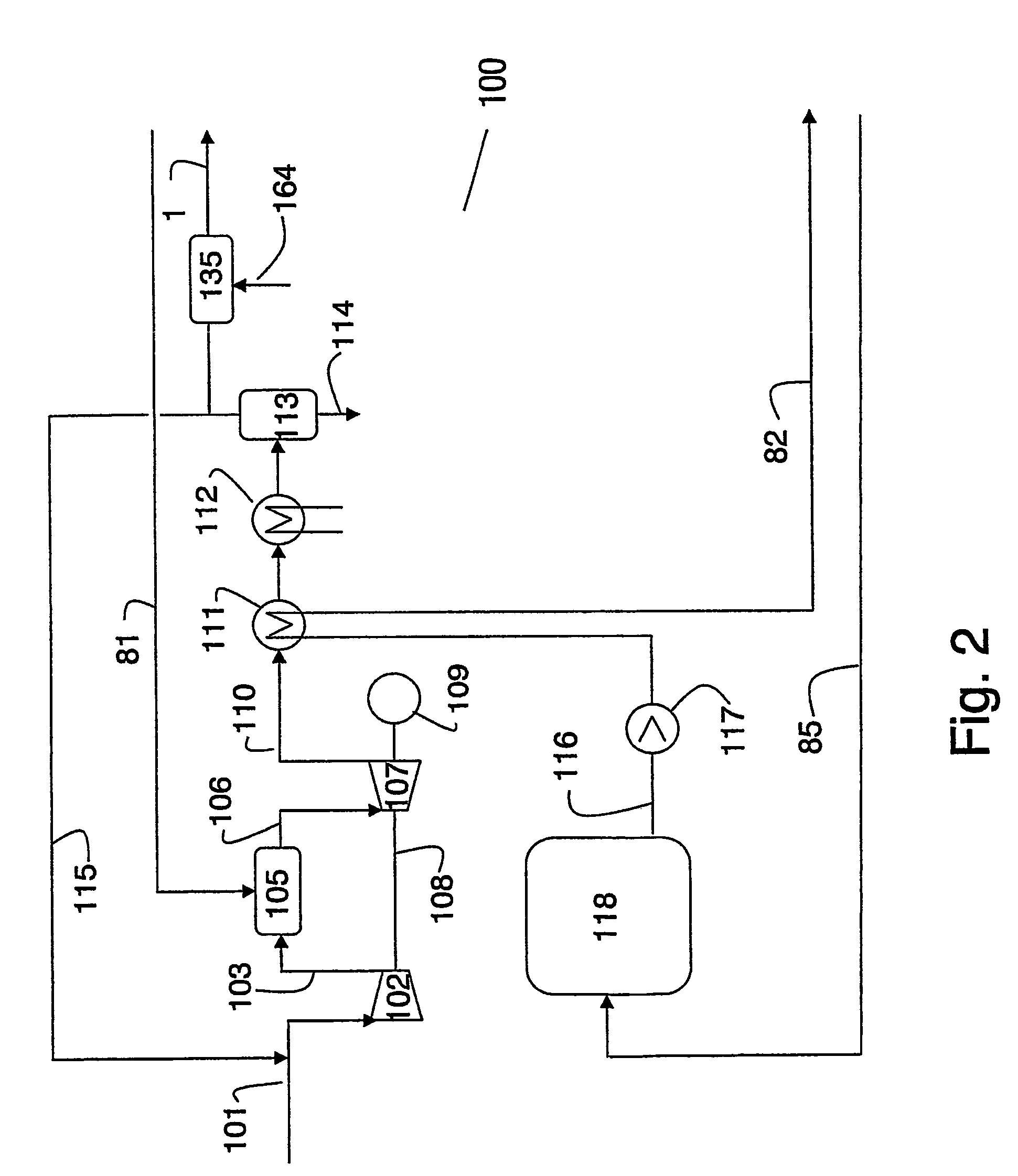Purification works for thermal power plant
a technology for purification works and thermal power plants, applied in the direction of emissions prevention, separation processes, lighting and heating apparatus, etc., can solve the problems of high cost of cleaning plants, low efficiency, and high cost of long-term and expensive development, so as to reduce heat loss in the system and increase the energy yield of plants
- Summary
- Abstract
- Description
- Claims
- Application Information
AI Technical Summary
Benefits of technology
Problems solved by technology
Method used
Image
Examples
example 1
CO2 Removal from a One Stage Gas Power Plant
[0094]FIG. 2 illustrates a one stage thermal gas power plant 100. Natural gas is taken out from the gas inlet 9 (FIG. 1) and, after heating in heat exchanger 80, led to the power plant 100 in a line 81 and introduced into a combustion chamber 105.
[0095]Air is introduced into the system through an air intake 101, compressed in a compressor 102 and led to the combustion through a line 103. The combustion gases from the combustion chamber 105 are led through a line 106 to a gas turbine 107, where the gas is expanded. The combustion chamber 105 and line 106 are illustrated as separate units but is normally integrated in the gas turbine 107. The compressor 102, the gas turbine 107 and a generator 109 for generation of electrical power are preferably mounted on a common shaft 108.
[0096]The expanded combustion gas from the gas turbine 107 is led through a line 110 via heat exchangers illustrated by heat exchanger 111 and trim cooler 112 before th...
example 2
CO2 Removal from a Two Stage Gas Power Plant
[0103]FIG. 3 illustrates a two stage thermal gas power plant. The elements corresponding to the elements described in Example 1 and illustrated in FIG. 2 have the same reference numbers and are not described again here unless regarded as necessary.
[0104]The flue gas leaving the first stage, corresponding to the thermal gas power plant in FIG. 2, is split into a recirculation line 115, as in FIG. 2, and secondary air line 120. It is also possible to omit recirculation line 115, and instead balance the flue gas rate from 113 and the volume flow requirement in line 120 by means of a not shown air inlet mixing box similar to 135. The exhaust gas from the first stage in the secondary air line 120 is introduced into the second stage, compressed in a compressor 121 and led to a combustion chamber 123 through a line 122. Natural gas in line 81 is introduced through line 81B as additional fuel into the combustion chamber 123.
[0105]The combustion ga...
example 3
CO2 Removal from a Thermal Coal Fired Power Plant
[0110]An exemplary plant is illustrated in FIGS. 4 and 5. FIG. 4 illustrates a combined thermal gas power plant and CO2 removal unit, and FIG. 5 illustrates a coal fired thermal power plant to be coupled with the plant at FIG. 4.
[0111]The plant according to FIG. 4 corresponds to the plant of FIG. 1 wherein lines 81, 82, 83, 85 and the pump 84 are removed and lines 87A and 87B and a heat exchanger 86 is inserted. The heat exchanger 86 heats incoming water in line 87A and cools the exhaust gas in line 41. The heated water leaves the heat exchanger in line 87B.
[0112]Carbon fuel is introduced from a coal line 150 into a combustion chamber 149 wherein the coal is combusted by introduction of air from a air feed line 151. The air in the air feed line is preferably preheated by heat exchanging in a heat exchanger 152 against the hot combustion gas leaving the combustion chamber 149 in combustion line 153.
[0113]The combustion gases leaving th...
PUM
| Property | Measurement | Unit |
|---|---|---|
| temperature | aaaaa | aaaaa |
| temperature | aaaaa | aaaaa |
| mean temperature | aaaaa | aaaaa |
Abstract
Description
Claims
Application Information
 Login to View More
Login to View More - R&D
- Intellectual Property
- Life Sciences
- Materials
- Tech Scout
- Unparalleled Data Quality
- Higher Quality Content
- 60% Fewer Hallucinations
Browse by: Latest US Patents, China's latest patents, Technical Efficacy Thesaurus, Application Domain, Technology Topic, Popular Technical Reports.
© 2025 PatSnap. All rights reserved.Legal|Privacy policy|Modern Slavery Act Transparency Statement|Sitemap|About US| Contact US: help@patsnap.com



